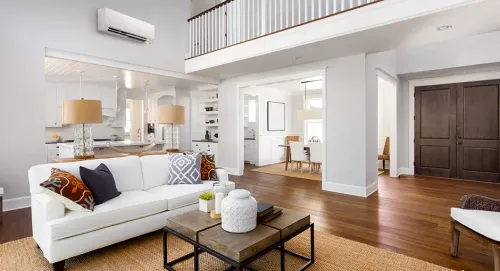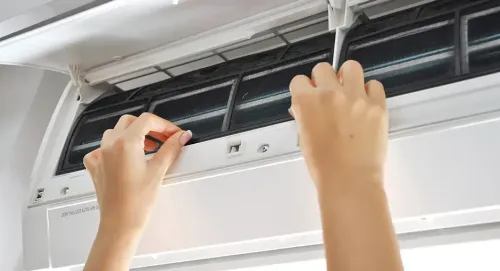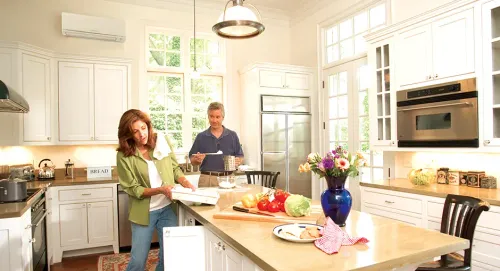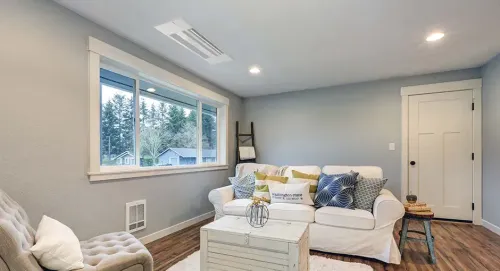Today, most U.S. homes have heating and/or air-conditioning systems. Depending on your region and climate, you may have both or just one, but chances are your home gets some conditioning at least part of the year.
Not long ago, things were very different! Despite being found in 87 percent of households today, air conditioning has only been common in American homes since the late 1960s. The next time your parents or grandparents gripe about your home being too chilly when they visit, cut them some slack — they likely grew up without the luxury of home cooling.
Heating systems are a different story. There’s documented evidence of early humans using campfires for warmth almost one million years ago. As dwellings have evolved, so have the go-to methods of heating. We’ve moved from campfires to fireplaces to fossil-fuel-burning furnaces to traditional heat pumps to the energy-efficient, all-climate heat pumps of today, able to provide heating and air conditioning all year long.
So, what’s the history of the modern heat pump?
Heat Pumps: The Origin Story
To understand how we’ve reached this innovative, energy-saving technology in our homes today, let’s look at the earliest heat pumps.
The very first heat pump system is credited to Austrian scientist Peter von Rittinger, who pioneered the technology in the 1850s. His heat pump used the same basic concept as today’s heat pumps: heat absorbed from air, water or the ground is transferred indoors to heat a space, and heat absorbed from indoor air is transferred outdoors to provide air conditioning. This early technology was used in salt mines — we know, a bit of a stretch from home heating — but stay with us.
In 1928, von Rittinger’s heat pump was first used for space heating in Geneva, Switzerland via a water-source system. As the pioneers in energy technology, the Swiss get credit for being the first to produce heat pumps in mass, with several companies jumping on the bandwagon. The original heat pump system installed in Zurich’s city hall in 1937 was used until 2001 — talk about some long-lasting technology!
By 1945, heat pumps were becoming more widespread. An American inventor, Robert C. Webber, experimented with the technology and created the first functioning ground-source heat pump system. They started getting attention as an option for American homes in the 1950s and 60s and gained ground when the 1970s oil crisis spotlighted the benefits of using electricity over fossil fuels.
Efficiency Joins the Party
Conventional heat pumps run at full capacity and power regardless of environmental conditions and typically overshoot the set point or desired temperature. This lack of precision causes conventional heat pumps to waste energy by cycling on and off as the indoor temperature drifts above and below the set point.
Heat pumps could get by with this kind of performance in the early 1990s, when the U.S. Department of Energy (DoE) set minimums for HVAC products’ seasonal energy efficiency ratio (SEER) and heating seasonal performance factor (HSPF) at 10 and just under 7, respectively. But as American homeowners began to grow increasingly energy-conscious in recent decades, and the DoE continuously raised efficiency standards, demand grew for more efficient heat pump technology.
Fortunately, the solution had already been in the works in Japan, where a combination of population density and increased energy costs (Japan had been hit especially hard by the 1973 oil crisis) had motivated engineers to design more energy-efficient buildings, appliances and systems decades ago. Japanese engineers developed the first inverter-driven compressors. Heat pumps with inverter-driven compressors save energy by running continuously and ramping capacity up and down as needed. Thus, the variable-capacity heat pump was born!
A New Generation of Heat Pumps
By adjusting capacity based on real-time comfort requirements, variable-capacity systems maintain set points consistently while only using minimal electricity. After decades of successful adoption in Japan and gradual expansion overseas, Mitsubishi Electric brought variable-capacity heat pumps to the U.S. in 2001.
This introduction revolutionized the American heating and air-conditioning industry. Still today, variable-capacity systems continue to gain attention as we navigate an increasingly energy-conscious world.
The variable-capacity heat pump technology available today is a testament to how far heat pumps have come since their humble beginnings. Homeowners enjoy superior comfort; environment-friendly, all-electric operation; reliable performance in all climates and reduced energy consumption by up to 40 percent compared to conventional heat pump systems.
If only von Rittinger could see his creation now!
For more information on our all-electric heat pump products and technologies, visit MitsubishiComfort.com.









